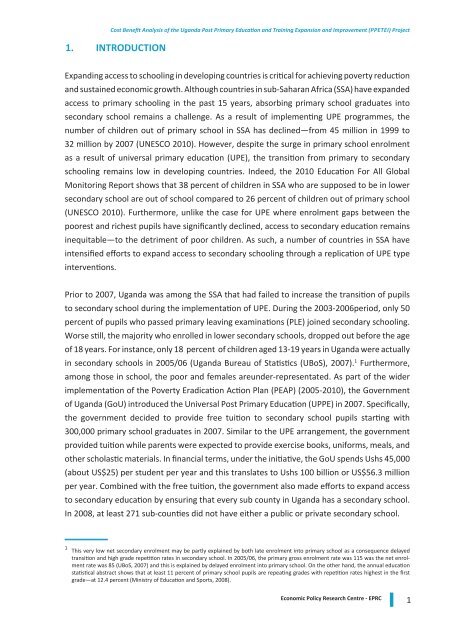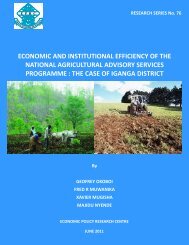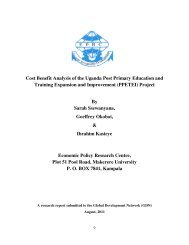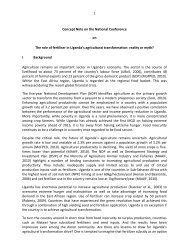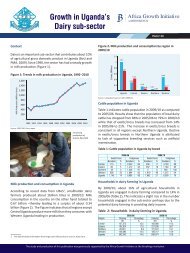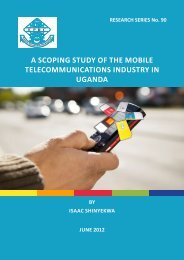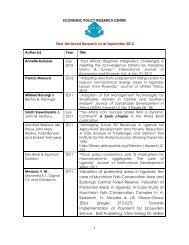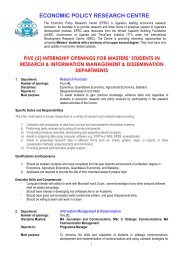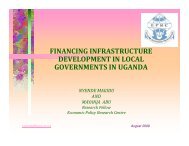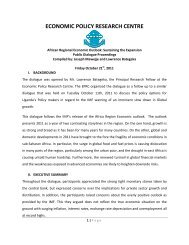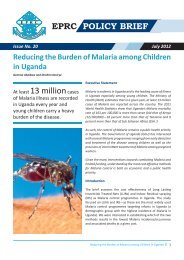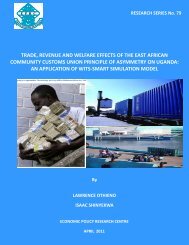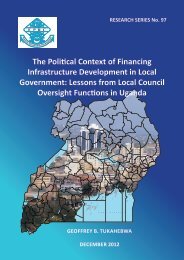CoSt BENEfIt ANAlySIS of tHE UgANdA PoSt PRImARy EdUCAtIoN ...
CoSt BENEfIt ANAlySIS of tHE UgANdA PoSt PRImARy EdUCAtIoN ...
CoSt BENEfIt ANAlySIS of tHE UgANdA PoSt PRImARy EdUCAtIoN ...
Create successful ePaper yourself
Turn your PDF publications into a flip-book with our unique Google optimized e-Paper software.
Cost Benefit Analysis <strong>of</strong> the Uganda Post Primary Education and Training Expansion and Improvement (Ppetei) Project1. IntroductionExpanding access to schooling in developing countries is critical for achieving poverty reductionand sustained economic growth. Although countries in sub-Saharan Africa (SSA) have expandedaccess to primary schooling in the past 15 years, absorbing primary school graduates intosecondary school remains a challenge. As a result <strong>of</strong> implementing UPE programmes, thenumber <strong>of</strong> children out <strong>of</strong> primary school in SSA has declined—from 45 million in 1999 to32 million by 2007 (UNESCO 2010). However, despite the surge in primary school enrolmentas a result <strong>of</strong> universal primary education (UPE), the transition from primary to secondaryschooling remains low in developing countries. Indeed, the 2010 Education For All GlobalMonitoring Report shows that 38 percent <strong>of</strong> children in SSA who are supposed to be in lowersecondary school are out <strong>of</strong> school compared to 26 percent <strong>of</strong> children out <strong>of</strong> primary school(UNESCO 2010). Furthermore, unlike the case for UPE where enrolment gaps between thepoorest and richest pupils have significantly declined, access to secondary education remainsinequitable—to the detriment <strong>of</strong> poor children. As such, a number <strong>of</strong> countries in SSA haveintensified efforts to expand access to secondary schooling through a replication <strong>of</strong> UPE typeinterventions.Prior to 2007, Uganda was among the SSA that had failed to increase the transition <strong>of</strong> pupilsto secondary school during the implementation <strong>of</strong> UPE. During the 2003-2006period, only 50percent <strong>of</strong> pupils who passed primary leaving examinations (PLE) joined secondary schooling.Worse still, the majority who enrolled in lower secondary schools, dropped out before the age<strong>of</strong> 18 years. For instance, only 18 percent <strong>of</strong> children aged 13-19 years in Uganda were actuallyin secondary schools in 2005/06 (Uganda Bureau <strong>of</strong> Statistics (UBoS), 2007). 1 Furthermore,among those in school, the poor and females areunder-representated. As part <strong>of</strong> the widerimplementation <strong>of</strong> the Poverty Eradication Action Plan (PEAP) (2005-2010), the Government<strong>of</strong> Uganda (GoU) introduced the Universal Post Primary Education (UPPE) in 2007. Specifically,the government decided to provide free tuition to secondary school pupils starting with300,000 primary school graduates in 2007. Similar to the UPE arrangement, the governmentprovided tuition while parents were expected to provide exercise books, uniforms, meals, andother scholastic materials. In financial terms, under the initiative, the GoU spends Ushs 45,000(about US$25) per student per year and this translates to Ushs 100 billion or US$56.3 millionper year. Combined with the free tuition, the government also made efforts to expand accessto secondary education by ensuring that every sub county in Uganda has a secondary school.In 2008, at least 271 sub-counties did not have either a public or private secondary school.1This very low net secondary enrolment may be partly explained by both late enrolment into primary school as a consequence delayedtransition and high grade repetition rates in secondary school. In 2005/06, the primary gross enrolment rate was 115 was the net enrolmentrate was 85 (UBoS, 2007) and this is explained by delayed enrolment into primary school. On the other hand, the annual educationstatistical abstract shows that at least 11 percent <strong>of</strong> primary school pupils are repeating grades with repetition rates highest in the firstgrade—at 12.4 percent (Ministry <strong>of</strong> Education and Sports, 2008).Economic Policy Research Centre - EPRC1


